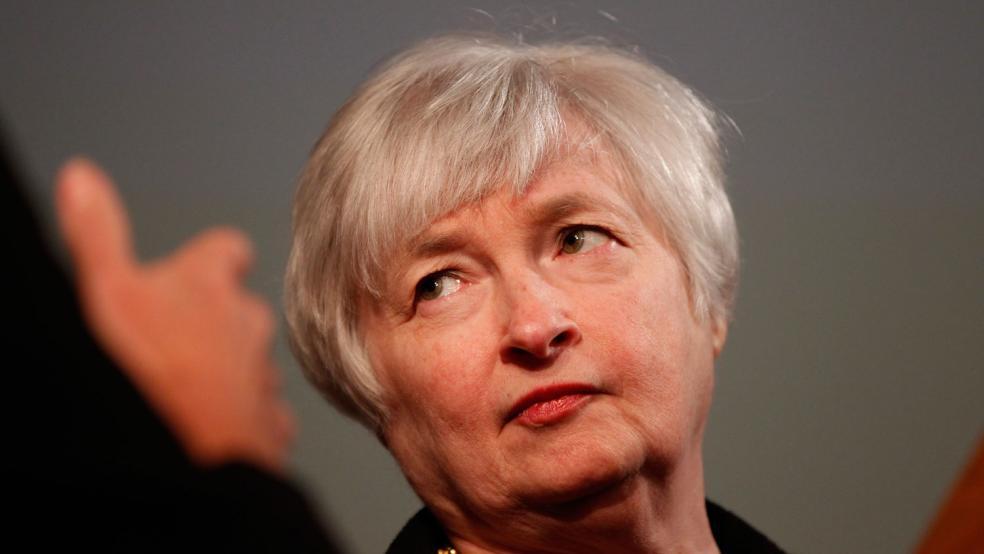After Janet Yellen’s excellent performance before the Senate Banking Committee last Thursday, she will almost surely be confirmed as the next Fed chair.
Once she’s confirmed, there are several important issues the Fed must address under her leadership such as improving the Fed’s communications with the public, ensuring that the financial sector is properly regulated, taking a stance on whether the Fed should pop bubbles, deciding whether to continue forward guidance in its present form, and so on. But the most important and most immediate problem Yellen will face during her term as chair is guiding the Fed to a smooth exit from its non-conventional policies.
The Fed’s non-conventional policies, quantitative easing in particular, have swollen its balance sheet to between four and five times its normal size, from $870 billion in August 2007 to 3.9 trillion on November 13 of this year. Reversing these policies is anything but a trivial task, and there are three main risks associated with the Fed’s exit from these policies.
Related: 4 Questions Janet Yellen Needs to Answer
Exiting too soon: If the Fed begins reversing its stimulus measures too soon it could make an already too slow recovery even slower, or stall the recovery altogether. This could be very costly, particularly to the extent that it adds to the number of long term unemployed. As a recent NY Times article explained, “The long-term jobless, after all, tend to be in poorer health, and to have higher rates of suicide and strained family relations. Even the children of the long-term unemployed see lower earnings down the road. The consequences are grave for the country, too: lost production, increased social spending, decreased tax revenue and slower growth.”
Selling financial assets too fast: As noted above, the Fed is holding approximately $3 trillion in financial assets over and above what it holds in normal times. If it sells these assets too fast, the sheer volume of sales could disturb financial markets and interfere with the financing of business investment, housing purchases, and consumer durables such as automobiles.
The main reason the Fed might want to sell assets quickly is to avoid or offset an outbreak of inflation. So far, there is no sign at all of an inflation problem, but suppose that the risk of an inflationary outbreak increases to the point where the Fed is compelled to take action. The problem is that with its balance sheet swollen far beyond its normal size, and with a huge quantity of reserves piled up in banks, it could take a large sale of financial assets before reserves fall enough to cause interest rates begin to rise. So large that it puts financial markets at risk.
However, now that the Fed can pay interest on bank reserve balances – a power granted to the Fed during the Great Recession – the chance that it will need to sell a large volume of assets to combat inflation is substantially reduced. Raising the interest rate on reserves freezes reserves inside banks since banks can make as much by holding on to the reserves as they can by making loans, and so long as reserves are frozen in banks rather than being used to finance new investment or consumption the inflation risk is minimized. Thus, the Fed does not have to put financial markets at risk by selling a large volume of financial assets should it need to fight inflation, it can raise the interest rate it pays on reserve instead.
Related: Janet Yellen—Brainy, Brave and Brooklyn Strong
Exiting Too Slowly: The final risk is that the Fed waits too long to begin reducing the size of its balance sheet. The main worry here is that a late exit would increase the risk of an outbreak of inflation and also cause inflation expectations, which have been well anchored throughout the crisis, to increase and become self-fulfilling.
It’s important to recognize, however, that the costs of an outbreak of inflation – which the Fed would very likely bring under control quickly in any case – would not be as costly as exiting too soon and adding to the unemployment problem. The main problems associated with inflation are the costs of changing prices frequently, difficulty making long-term commitments due to uncertainty about future inflation rates, and unintended redistribution of income.
However, the cost of changing prices, i.e. the “menu cost” as it is known isn’t as costly as it once was due to computers and digital technology. And uncertainty about future inflation rates and redistribution is not a big problem so long as the Fed brings inflation under control within a reasonable amount of time, as I have no doubt it would under Yellen’s leadership.
Thus, and importantly for policy, despite what the inflation hawks would have us believe the expected costs of exiting too slowly and potentially experiencing an outbreak of inflation are not as large as the expected costs of exiting too soon and slowing the recovery even further. Fortunately, while a Yellen Fed is unlikely to tolerate a large increase in inflation, I am very confident that Yellen understands very well that if a mistake is to be made; exiting too soon is more costly than exiting too late. That’s one of the reasons I am such a strong supporter of her nomination to be the next Fed chair, and so pleased it looks as though she will be confirmed.
Top Reads from The Fiscal Times:
- Guess Which Jobs Are Poised for the Most Growth?
- Guess Who’s Challenging Chris Christie for the GOP Top Spot?
- The Bitcoin Gamble: Is Now the Time to Invest?






